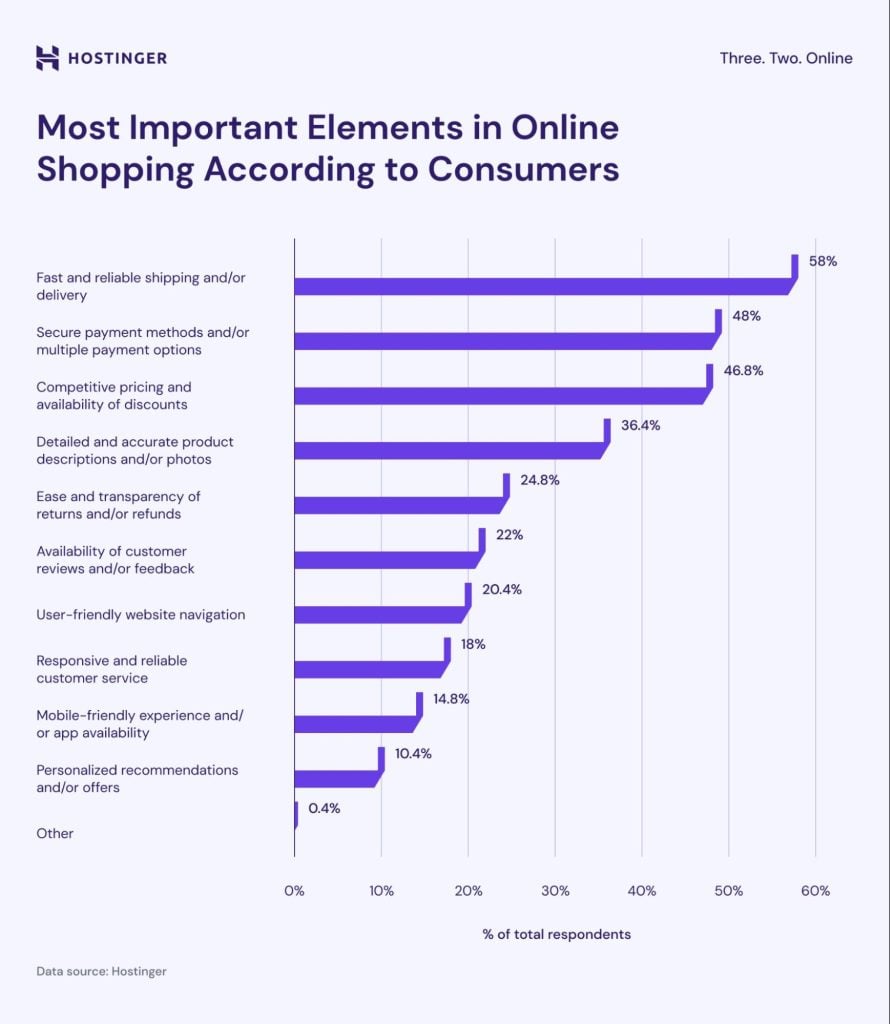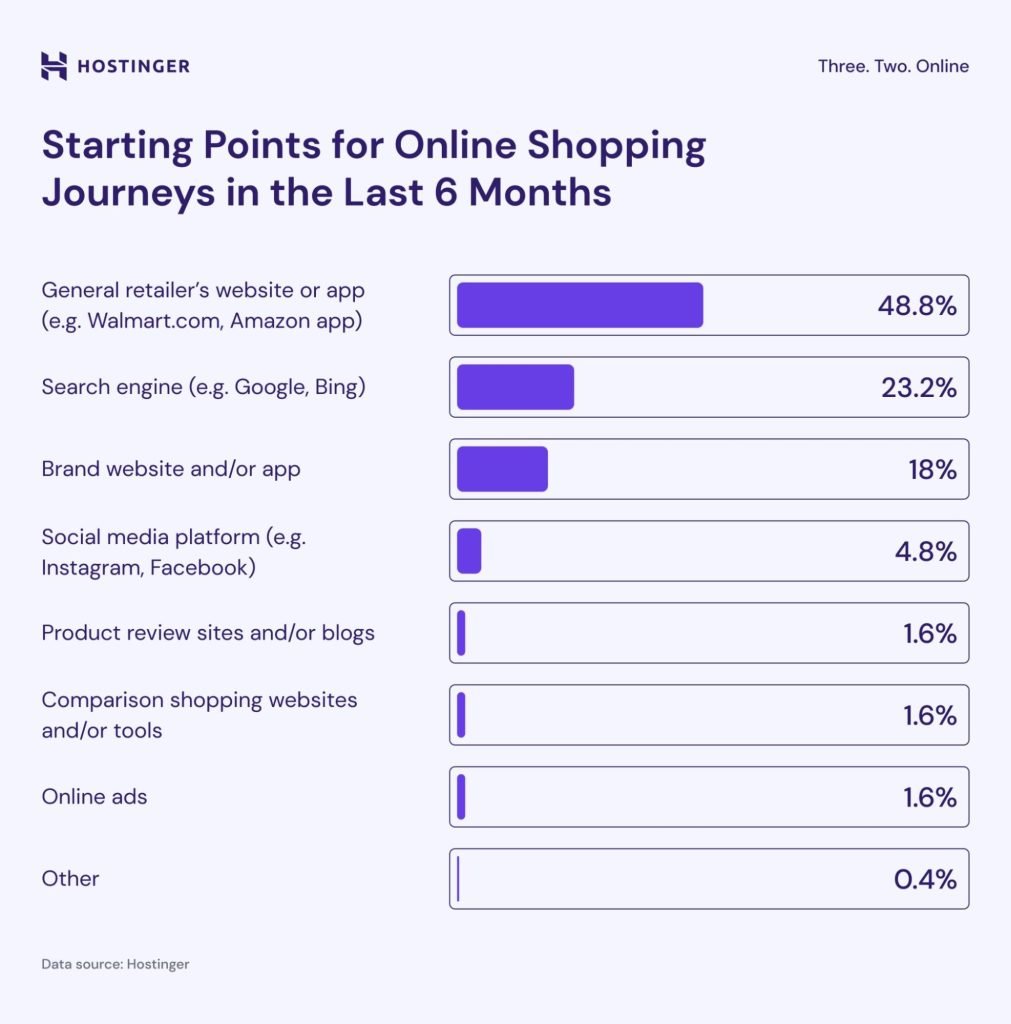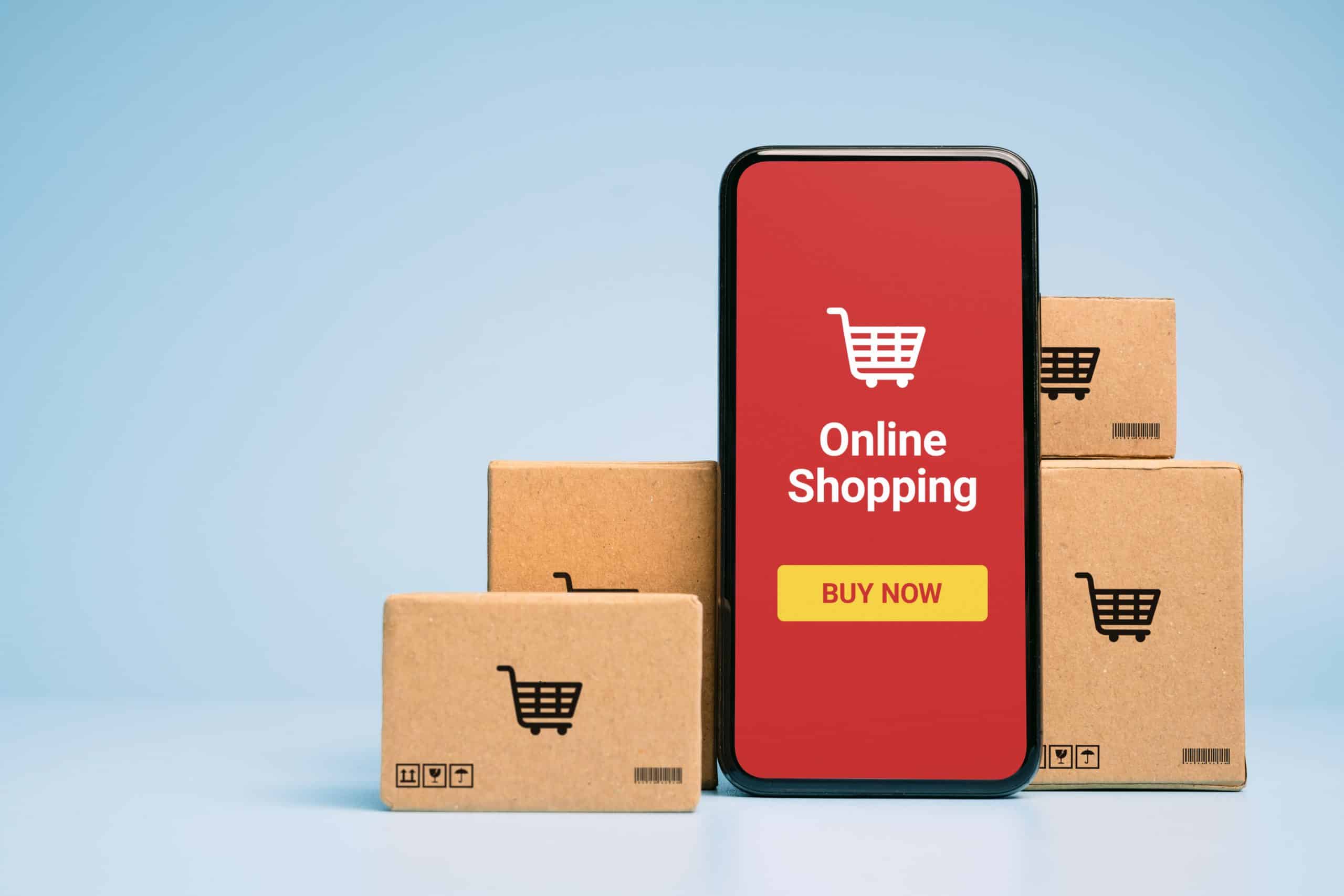- Trend 1: The Continued Growth of Personalization and Customer Experience
- Trend 2: The Dominance of Mobile Commerce and Shoppable Content
- Trend 3: The Power of Social Commerce and Influencer Marketing in E-commerce
- Trend 4: The Importance of Data Analytics and Marketing Automation in E-commerce
- Trend 5: The Evolving Role of SEO and Content Marketing in E-commerce
- Trend 6: The Rise of Re-Commerce
- Key E-commerce Moments in 2025
- How to Determine If an E-commerce Trend is Right for Your Business
- Key Takeaways
- Frequently Asked Questions (FAQs)
E-commerce marketing and its related technology are often at the forefront of innovation. Whether it’s augmented reality (AR) and virtual reality (VR), sophisticated AI chatbots, or live-streamed shopping experiences, e-commerce is a place to experiment and set the pace for other industries. The goal remains the same, though: Attract more customers and keep existing ones coming back.

[Source: Hostinger]
It’s clear that growth is continuing amid these maturing tech platforms and channels. In 2023, researchers predicted that e-commerce would pass the $1 trillion mark: Now, new data shows that number was more than five times higher than expected, at $5.6 trillion. The same research shows that it’s expected to grow to 22.9% of total sales worldwide by 2028.
In 2025, growth continues amid maturing tech platforms and channels. There’s a lot to consider in attracting and keeping e-commerce customers, and five trends to keep in mind, which I’ll get into below, but first, some memorable stats:
- Retail e-commerce sales are estimated to exceed $4.3 trillion worldwide in 2025.
- The highest total e-commerce revenue is in fashion, with a total of $990 billion.
- There are about 2.71 billion online shoppers as of 2024.
Trend 1: The Continued Growth of Personalization and Customer Experience
The convergence of big data, powerful analytics tools, AI capabilities, and advances in digital advertising technology all mean that modern e-commerce companies have the tools to offer interesting, personalized experiences. Here’s more detail on how businesses are moving personalization and customer experience forward:
Using Data and AI for Personalization
With rich, first-party data, e-commerce businesses can create personalized customer experiences. Relevant data points include customer behavior and history, along with demographic and other gathered information, to segment audiences and build tailored buyer journeys. E-commerce businesses are also using predictive analytics and AI-powered recommendations for faster, automated customer recommendations.
E-commerce companies have to pay close attention to price, too, particularly in economically challenging times. Last year, 60% of consumers switched from a brand they were loyal to because of cost considerations.
Marketers can use all this information to surface relevant product suggestions, show unique website content in real time, send personalized messaging, use email strategically, and highlight price drops, special offers, or better cost vs. competitors.
Realize leverages Taboola's extensive first-party data from powering publisher editorial and ad units, providing unmatched insights and targeting capabilities.
Creating Exceptional Digital Experiences
In addition to personalized experiences, modern consumers also assume they’ll get nicely designed, dependable shopping and buying journeys on any site or platform. Shoppers will quickly navigate away if a site doesn’t use responsive design for mobile or loads too slowly. Creating pleasant browsing experiences can also help stand out from the competition, whether that’s curated collections, advice available via chat, virtual try-on, outfit or accessory suggestions, and more. E-commerce users also require intuitive navigation and one-stop checkout. Marketers should make sure to reduce the number of steps required of a shopper to increase conversions, sales, and returning customers.
In addition, it’s important to make sure that any information a customer might need is easy to find. That includes transparent shipping and delivery data, return options, and multiple options to reach customer service. Also, offering as many payment methods as possible makes it easy for users to buy. Clear communication and an easy purchasing process also helps build trust and authority for e-commerce brands.
Here’s what else to know:
- Conversion rates can increase by 17% for every one second faster that a site loads.
- $260 billion of lost e-commerce orders can be recovered by creating a better checkout design. Also of note: 48% of users abandoned their cart during checkout because extra costs were too high.
- Personalized content can increase revenue more than 25% and improve a customer’s chances of spending more than planned by more than 40%.
Trend 2: The Dominance of Mobile Commerce and Shoppable Content
Mobile commerce has overtaken desktop browsing, and continues to grow. E-commerce keeps pushing the limit on what’s possible for shoppers and buyers, too, so here’s what to keep an eye on.
Thinking Mobile-First
E-commerce companies should put mobile browsing and shopping first, but also keep in mind the broader omnichannel market, and the more complex buyer’s journey that mixes online and offline browsing. A customer might buy products online and pick up in-store, or buy online and return in-store, or make part of a purchase in-store and the rest online if a product isn’t available in-person. Convenience is everything for modern shoppers. As consumers move quickly across search, social, and other platforms, it’s important to make sure the brand is represented consistently and positively and that products are also displayed consistently.
Going Live
Mobile e-commerce has become commonplace, and live-streamed, real-time shopping experiences are likely to be the next big leap in many countries. It takes some creativity and innovation to stand out from the crowd with live e-commerce, such as with product demos, exclusive product offerings, and partnerships with influencers to reach more viewers.
Tech Tools
Combining audience knowledge with available technology can lead to some positive outcomes. An app, for example, acts as an entirely owned channel to reach and convert prospects: That could include app-only offers, push notifications, and other techniques and tactics that make sense. Another new technology in circulation with e-commerce brands is AR, which can bring prospects closer to the products virtually.
cHere’s what else to know:
- Nearly 80% of all retail website visits were on smartphones worldwide in 2025.
- 75% of consumers will carry out a purchase from start to finish on their mobile phone.
- 40% of consumers would pay more for a product they could customize in augmented reality.
Trend 3: The Power of Social Commerce and Influencer Marketing in E-commerce
Lots of e-commerce innovations over the past few years have been related to social media and entities outside of the traditional brick-and-mortar businesses. Consider the following:
Social Media Evolves
E-commerce businesses have found new, varied ways to monetize social media platforms. The platforms themselves have added features so that e-commerce companies can set up direct-sale shops inside of Instagram, TikTok, and others. To make this go smoothly, make sure there are resources to support this type of selling. In addition, use the available features on the particular channel, like shoppable ads, along with contests or live shopping options to engage audiences.

[Source: Hostinger]
Influencers Take the Spotlight
E-commerce marketers and advertisers might be driving most of a business’ tactics, but influencers can be hugely important for brands to attract new prospects and drive conversions. It’s important to choose the right influencer for the brand, and pick the partnership type (e.g. sponsored content, product collaborations, brand ambassadorship, etc.) that best fits the business, too. Influencers can help build trust, as they provide testimonials, photos, videos, and other authentic, credible content.
Consider how upcoming generations factor into this, too. Recent data shows that Gen Alpha may already be impacting the way in which purchases are made, with 70% of parents saying they buy products for their children based on their child’s favorite character or show fairly often.
“For Gen Alpha, what’s going to be really imperative for e-commerce brands is kind of shifting back to the 1950s, where you’re sponsoring content and having native placements,” points out Lauren Petrullo, CEO and founder of Mongoose Media and co-founder of Asian Beauty Essentials. “You’re doing product placement inside the programming, because most Alphas think, ‘How dare you assault me with a commercial. The audacity to steal my attention for your business!’ But, if you do it well, and you can interrupt that space, there’s going to be such a good market for you.”
Also keep in mind that Gen Alphas can be business owners themselves, and the distribution of generational wealth is different than previous generations. “Gen Alpha includes millionaires before 14, because these are YouTubers,” says Petrullo. “These content creators are doing live shopping to provide a hybrid experiential type of environment for those that are virtual and can’t be physically in there, and for those that don’t have stores anymore, because retail is a hard experience for a lot of people. This is the first time that we have generational wealth established before someone becomes an adult — they have employees and they have massive purchasing power.”
Measuring the ROI of social and influencers can include attribution and channel-specific numbers, so it’s easy to tell how well various tactics are working. Metrics can include the basics, like reach, engagement, and conversions.
Here’s what else to know:
- 50% of e-commerce brands use social media personnel to influence their store’s conversions.
- The top social media app for e-commerce purchases is Facebook.
- 33% of consumers trust an influencer’s opinion when shopping online.
Trend 4: The Importance of Data Analytics and Marketing Automation in E-commerce
Without trusted data and accompanying technology, e-commerce businesses likely can’t keep up. These broad areas of focus can help companies build successful pipelines.
Data Analytics
With an ongoing shift away from third-party cookies, e-commerce businesses are gathering first-party data from customers — generally more accurate than third-party, and a way to build deeper relationships. Analyzing this data alongside all the other information a business collects offers a window into what’s working, and what isn’t. Data points can include customer interactions, purchase history, and demographics; individual product performance, average order value, and customer lifetime value; and conversion rate along with traffic data from web, social, and other channels.
The results of analyzing this data can lead to personalization and better journeys, but also cost savings, reduced overlap or redundancy, improved customer retention, better cart completion, and more efficient campaigns. E-commerce marketing teams already do A/B testing to improve their metrics, but data analytics can be applied to areas like inventory management, as well, and at an advanced level can provide predictions on sales trends and other areas. It’s these types of approaches that help e-commerce businesses to truly make data-driven decisions.
Marketing Automation and Other Tools
E-commerce marketing isn’t a task that can be done manually in 2025: For even startups or very small businesses, the work of reaching and converting prospects intelligently and efficiently across multiple channels is simply too much. AI and other automation advances in online marketing mean that marketers can now perform data analytics and build a customer journey accordingly, then deliver and manage communications across channels, including email and social. Using marketing automation for e-commerce can streamline customer communication to eliminate excess contact, too, and many platforms incorporate AI for chatbots and assistants.
Here’s what else to know:
- 51% of shoppers prefer e-commerce businesses with live chat support.
- Email marketing provides the highest ROI for e-commerce companies, earning an average of $36 for every $1 spent.
Trend 5: The Evolving Role of SEO and Content Marketing in E-commerce
SEO remains a crucial piece of e-commerce customer acquisition in 2025. As the discipline continues to evolve, e-commerce marketers should build a solid strategy with new opportunities in mind.
Using SEO for Acquisition
E-commerce teams can use SEO and AEO (answer engine optimization, i.e., content designed to be picked up by ChatGPT or Google’s AI Overview, etc.) to attract targeted traffic, boost conversions and engagement, and build and maintain brand visibility. Paid search is also still a viable tactic, depending on budget and market saturation, but organic search serves as a low-cost, always-on channel that can steadily drive traffic.
Good e-commerce SEO and AEO practices include optimizing web product pages, keyword targeting, and creating useful content for prospects at all funnel stages. Content marketers in e-commerce companies should use rich keywords in content and aim to inform and educate readers about products and trends on the path to conversion. Content marketing tactics in e-commerce range from reviews and user-generated content to video and audio.
Voice Search
Voice search is an emerging trend in e-commerce, as smart speakers and phone assistants become more sophisticated and useful. Consumers can shop easily (then purchase and track orders) with these hands-off options, so putting resources into voice search optimization is something marketers should consider. Get to know the tenets of voice search, such as optimizing for natural language and using long-tail keywords.
Here’s what else to know:
- 32% of consumers globally are using voice assistants weekly, and voice assistant users are 33% more likely to have made an online purchase in the past week.
- 18% of local searches will lead to a sale within 24 hours.
- Product pages that used the exact keyword in the meta description ranked better than those that didn’t.
- 57% of users don’t buy from a business online if it has less than a four-star rating.
Trend 6: The Rise of Re-Commerce
As sustainability continues to grow to top of mind in shoppers’ priority lists, re-commerce — i.e., selling used products online — continues to gain popularity, with 65% of shoppers aged 18-24 likely to have bought preowned goods within the last 12 months. Brands are having fun with it, and customers are enjoying reduced prices: For example, children’s clothing brand Hanna Andersson has “Hanna-Me-Downs,” reflecting the secondhand fashion market, which alone is projected to reach $350 billion by 2028.
Key E-commerce Moments in 2025
New Year: January provides a chance to clear holiday inventory while capitalizing on the “new year, new me” mindset for fitness and seasonal products.
Super Bowl: The Super Bowl (Feb 9) could boost demand for campaigns centered on snacks, drinks, and home entertainment. Marketing teams can use this as a comeback moment for customers who haven’t engaged in the buying cycle after a leaner post-holiday spending month in January.
Valentine’s Day: This couple-focused day offers a prime moment to focus on personalized gifts, luxury items, and memorable experiences.
Black History Month: February is ideal for spotlighting Black-owned businesses, creators, and cultural contributions. Authentic storytelling, along with curated collections and guides, can help brands connect with value-driven consumers.
Tax season, wellness, and Presidents’ Day: Presidents’ Day (Feb 17) is a strategic time for promotions on home goods, appliances, and tech. Shortly after, tax refunds may encourage big-ticket purchases.
Spring break and spring cleaning: Spring break planning might boost travel-related purchases, in addition to spring cleaning content and product opportunities.
Memorial Day: With summer officially here, promotions around outdoor gear, travel, and family gatherings will all resonate well.
Fourth of July: Focus on summer fun here, with bold, festive visuals. Highlight limited-time offers on BBQ supplies, summer- and holiday-friendly apparel, and outdoor products for back yards, beaches, and pools.
Amazon Prime Day: Optimize your Amazon listings and ads to capitalize on high-intent shoppers and increased traffic, emphasizing urgency and exclusivity, especially for deals on tech and home products.
Back to School: Marketers should plan to target parents and students with budget-friendly bundles, organizational tools, and time-saving solutions, using messaging around preparedness and new beginnings.
Halloween: Spooky season is the time to have fun with your marketing, while promoting costumes, candy, and decorations. You can also experiment with limited-time products and UGC to drive engagement.
Black Friday: Deep discounts and doorbuster deals are the order of the day here: Play up the urgency and scarcity angles, and try to create advance buzz with email teasers and VIP early access events.
Cyber Monday: Ensure everything is optimized for smooth, high-traffic experiences and focus on online-only convenience, flash sales, and extended weekend deals.
Christmas: Round off the year with warm, family-oriented messaging, and promote gift guides, shipping cutoff dates, and bundle deals to help people feel more at ease amidst the holiday stress.
How to Determine If an E-commerce Trend is Right for Your Business
While it might be tempting to tackle all of the latest trends, it’s important to keep in mind that some might not be the perfect fit for your business or client. Petrullo gives the example that not all businesses have the resources to do live shopping, saying that, “If it causes you too much stress and it’s not something you’re comfortable with, then don’t submit — there’s a thousand and a half other things you can do.”
Petrullo does encourage businesses to be willing to look bigger and consider under-utilized resources, though — even if it makes them uncomfortable. “If you have a TikTok shop and you can tap into the affiliate program, you can unlock a herd of sales people to promote your business and your products,” she says. “We’ve had clients that do $30,000 days overnight by launching a TikTok shop and having a strategic affiliate marketing plan.”
Key Takeaways
E-commerce marketing has already started to popularize live and social shopping, and offers a testing ground for emerging technology like AR and voice search. E-commerce marketing trends in 2025 include the use of sophisticated data analytics, incorporation of AI, automation wherever possible, and personalization. Understanding the different roles generations play in your sales can also help you strategically plan your promotions and the growth of your e-commerce business through social media channels.
Frequently Asked Questions (FAQs)
What are the most effective digital advertising channels for e-commerce in 2025?
E-commerce digital advertising will continue to span a range of channels. The best channels in 2025 are a combination of paid and organic, all focused on targeting prospects and turning them into repeat customers. Successful e-commerce marketing channels also include user-generated content, live streams, performance marketing channels (e.g. PPC and online advertising) and social platforms.
How can e-commerce businesses reduce cart abandonment?
Cart abandonment remains a typical challenge for e-commerce businesses. With lots of digital tools available, businesses can use data to understand why customers abandon their carts. Teams may try streamlining the checkout process, including shipping and fee information up front, opening a guest checkout option, and testing personalized retargeting to re-engage customers.
What are some successful examples of e-commerce digital marketing campaigns?
Successful examples of e-commerce digital campaigns include the Dove Campaign for Real Beauty, which built brand and messaging alongside memorable photos, and Spotify’s Wrapped campaign, which sparked lots of copycats and conversation among users.
How is AI impacting the e-commerce marketing landscape?
AI is playing a big role in e-commerce marketing, particularly in the areas of personalized experiences. Even small marketing teams can get help from AI in analyzing tons of customer behavior and predicting trends. In addition, AI can help teams automate tasks to become more efficient without adding resources.
What are the key metrics for measuring success in e-commerce digital marketing?
E-commerce digital marketing tracks similar metrics to other industries, such as customer acquisition cost, web traffic, and customer lifetime value. Metrics specific to measuring success in e-commerce include the sales conversion rate to measure how many site visitors make a purchase, the cart abandonment rate, average order value, and return rate.



